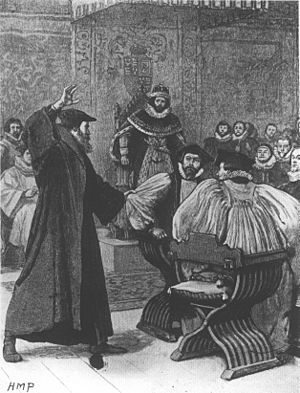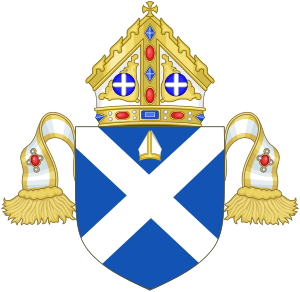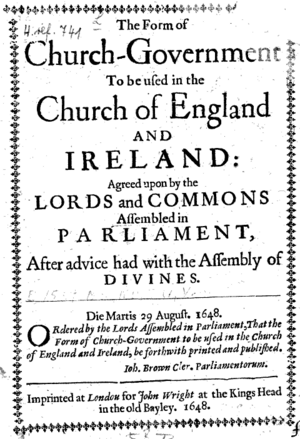Bishops in the Church of Scotland facts for kids

The Church of Scotland, often called "the Kirk," doesn't have bishops in the same way some other churches do. Bishops are church leaders who oversee a group of churches or a specific area. While the Church of Scotland hasn't had bishops since the 1600s, there have been times when people tried to bring them back.
Instead of bishops, the Church of Scotland uses a system called Presbyterianism. This means that decisions are made by different church councils or "courts," not by one single leader. However, the idea of a "bishop" as someone who "oversees" is still present in some ways, and there have been talks about using this idea more widely.
Contents
What is a Bishop? A Look Back in Time
The word bishop comes from the Greek word episcopos, which means "overseer." This word is found in the New Testament of the Bible. In the early days of Christianity, by the 200s AD, both the Eastern (Orthodox) and Western (Catholic) churches had bishops as important spiritual leaders.
After the Protestant Reformation in the 1500s, some churches, like the Lutheran and Anglican churches, kept the system of bishops. But other churches, like those that followed the ideas of the radical reformation, didn't want bishops. They felt that giving too much power to a few individuals had caused problems in the church before the Reformation.
During the Scottish Reformation, a famous reformer named John Knox first thought about having bishops in the Church of Scotland. However, people eventually preferred the Presbyterian system. This system is very open, as all decisions are made in public meetings, which was seen as a good thing.
In the 1600s, there were many arguments and even wars (Bishops' Wars) in Scotland about whether the church should be run by bishops (Episcopalianism) or by church councils (Presbyterianism). The Scottish kings often supported bishops. In the end, the Presbyterians won, and a separate church called the Episcopal Church of Scotland was formed in 1690 for those who wanted bishops.
How the Church of Scotland Saw Other Church Leaders Long Ago
In 1645, the main meeting of the Church of Scotland, called the General Assembly, approved a document about how the Presbyterian church should be run. This document, called The Form of Presbyterial Church Government, didn't list bishops as a separate church job. It listed other roles like pastors, teachers, and deacons.
However, this didn't mean the Church of Scotland thought that leaders ordained by Anglican bishops in the Church of England were not valid. In fact, if a minister from the Church of England wanted to join the Church of Scotland, they could. They just needed to be checked to make sure they were suitable. They didn't need to be ordained again. This showed that the Church of Scotland respected the ordinations done by Anglican bishops.
The Word "Bishop" in the Church of Scotland Today
Even though the Church of Scotland hasn't had bishops since 1690, the word "bishop" is still used in the Bible. So, it's not surprising that a church that focuses on the Bible would still use the word in its original meaning: "someone who oversees."
Today, in the Church of Scotland, a minister who guides someone training to become a minister is sometimes called the student's "bishop." This happens when theology students do work placements in churches or when new graduates complete a year of training before becoming fully ordained. However, most regular church members don't know about this special use of the word.
Ideas to Bring Back Bishops
In the late 1900s, there were some discussions about bringing back the idea of bishops. While church councils (presbyteries) are open about their decisions, they sometimes struggled to provide good care for individual ministers. This was a problem the church often tried to solve.
One idea was to have presbyteries appoint full-time or part-time bishops. These bishops would not have the same power as bishops in other churches. Instead, their main job would be to care for and support the ministers on behalf of the presbytery. Some churches in other countries, like the Uniting Church in Australia, already had a similar "mixed system."
The most serious attempt to bring bishops back happened in the 1980s. The Church of Scotland tried to unite with the Scottish Episcopal Church. The Scottish Episcopal Church said that for the union to happen, the new church would need to have a form of bishops that they would recognize. The plans for this union were almost complete and were approved by the Church of Scotland's General Assembly. However, when the plans were sent to the local church councils (presbyteries) for a final vote, they were rejected. This happened under a rule called the Barrier Act.
In the 1990s, another effort called the Scottish Churches Initiative for Union (SCIFU) tried to unite the Church of Scotland, the Scottish Episcopal Church, the Methodist Church in Scotland, and the United Reformed Church in Scotland by 2010. This plan also included a form of episcopal oversight (having bishops). However, after much discussion, the Church of Scotland's General Assembly rejected the SCIFU proposals in May 2003.
One idea for the structure of a united Scottish church was described as having "Maxi Parishes." In these, different church groups would work together under one leadership. These groups would then be part of larger "Regions," with a bishop and a "Regional Council" in charge at that level.
Recent Agreements Between Churches
In the 2000s, the Church of Scotland made two important agreements. One was with the Church of England, and the other was with the Scottish Episcopal Church. These agreements recognized the idea of "oversight" (episkope) in each other's churches. However, they didn't fully combine their different ways of organizing church leadership.
The St Columba Declaration
The St Columba Declaration was written in 2015. It came from a joint study group of the Church of England and the Church of Scotland. This happened after the 2014 Scottish independence vote and built on an earlier report from 2010.
The St Andrew Declaration
The St Andrew Declaration came from a working group of the Church of Scotland and the Scottish Episcopal Church. It was approved by the Church of Scotland's General Assembly in May 2021 and by the Scottish Episcopal Church's General Synod in June 2021. This declaration was signed on November 30, 2021. It is very similar to the St Columba Declaration, but the Scottish Episcopal Church had felt left out of the St Columba Declaration, which caused some upset.
What These Declarations Say
Both declarations acknowledge that the churches belong to the "One, Holy, Catholic and Apostolic Church of Jesus Christ." They also agree that God's word is truly preached and the sacraments (like Baptism and Holy Communion) are properly given in each other's churches.
They also recognize that each other's ordained ministers (like pastors and priests) are given by God and are instruments of grace. Both declarations look forward to a time when ministers from one church can serve in the other.
Importantly, both declarations state that "personal, collegial and communal oversight (episkope) is embodied and exercised in our churches in a variety of forms." This means they recognize that different churches have different ways of overseeing their work and leaders.
The declarations also include commitments to:
- Pray for and with one another.
- Welcome each other's members to worship and participate in church life.
- Explore opportunities for churches to work together, especially if they are close to each other.
- Discuss theological issues that come up as they grow closer.
- The St Andrew Declaration specifically adds commitments to work towards sharing ministry and resources, and to encourage local partnerships.
See also
- Five Articles of Perth
- The Killing Time
- Tulchan



